Module2unit1教案《1》
最新五年级上册外研英语Module 2教案Unit 1

Module 2 Unit 1 This one is heavy.模块整体分析:主要语言功能:学习购物用语,并正确描述物品。
主要语言结构:There are many sweets.There is a lot of fruit, too.There one is heavy.主要词汇:heavy, let, sell, sometimes一、教学目标与要求:1. 知识目标:能听、说、读、写单词heavy, let能理解并运用What引导的感叹句。
能听、说、读、写句子There are many sweets. And there is a lot of fruit, too. This one is heavy.2. 能力目标:指导学生抓住关键信息,培养良好的听、说、读习惯,与他人合作交流的能力。
3. 情感目标:培养学生乐于帮助别人,互相帮助的精神。
二、教学重点及难点:1.本节课的教学重点是学习用形容词来描述物品及其特征。
2.本课的难点是对what引导感叹句的理解及其运用;正确使用This …is… / These …are…。
三、教学流程:Step 1 Warm up1. Greetings2. sing a song <There was a chicken.>Step 2 Presentation and Leading in1. T: Let’s play a guess game. What’s this? Children, Can you guess? What’s in my hands? It’s …Ss: It’s a ball.T: What colour is it?Ss: It’s yellow.T: Is it big?Ss: No, it isn’t.T: Good! It’s big. But it’s not heavy.(教授:heavy)Look at this one! Who wants to try? It’s heavy or light. Can you carry it ?Ss: No, I can’t.T: Why?Ss: Because it’s heavyT: Good! This one is heavy and small.T: Sam has got a ball, too. Is it heavy? Do you want to know?Sam has got a ball, too. Is it heavy? Do you want to know?2. Let’s listen.3. Listen and read.4.借着导入图的第二幅图片This ball is very heavy, so Sam is very tired. Now Look at this one .出示主体课文第一幅图,然后说:T:Is Sam very tired?Ss: No, he isn’t. T: He’s very happy, because they are going to go to the supermarket. Do you want to go to with them? So Let’s learn Module 2 Unit 1 This one is heavy. 本节课我们学习用形容词来描述物品的特征。
外研版六英语Module 2《Unit 1 When are we going to eat?》教案

外研版六年级下册英语Module 2《Unit 1 When are we going to eat?》教案一、教材分析:本教材是外研版六年级下册 Module 2《Unit 1 When are we going to eat?》,主要包括两个对话:活动一和活动二。
通过这两个对话,学生将学习如何运用一般将来时态表达将来的活动,并学会用句型"When are we going to...?" 来询问时间并进行回答。
同时,学生还将通过对话了解和体会大自然的美丽,培养对待动物的正确看法。
二、教学目标:1. 语言知识目标:能够听、说、读并理解活动一和活动二的对话。
能够运用 "be going to + 动词原形" 来表达一般将来时态。
能够用句型 "When are we going to...?" 来询问时间并进行回答。
能够正确朗读活动二的对话。
2. 思维能力目标:能够对语篇信息进行分析。
能够体会提问的技巧。
3. 学习能力目标:能够通过教学活动调动学生的积极性,在教师创设的情境中大胆尝试用英语进行交流。
4. 文化意识目标:能够体会大自然的美丽,培养正确对待动物的看法。
三、教学重难点教学重点:能够用一般将来时态的句型来提问并能够回答对活动二对话的理解和认读。
教学难点:对一般将来时态句子的正确运用。
四、学情分析:学生是六年级学生,已经学习了一些基础的英语知识,包括一般现在时态和一些基本的句型。
他们对于时间的表达和询问可能还不够熟练,对于一般将来时态的句子运用也需要进行深入的学习和训练。
在兴趣方面,学生对于大自然和动物可能有一定的好奇和兴趣,可以通过这些主题引发他们的学习兴趣。
五、教学过程:Step 1: Lead-inShow pictures of different activities such as eating, playing, and reading on the board or using a multimedia tool. Ask students to name the activities they see. Encourage them to use complete sentences, such as "I see someone eating."Elicit the question "What are you going to do?" and explain that we can use this question to ask about future plans. Write the question on the board.Teacher: What activities do you see in the pictures? Let's describe them using complete sentences. For example, "I see someone eating."Student 1: I see children playing soccer.Student 2: I see a girl reading a book....Step 2: PresentationPresent the dialogue for Activity 1 on the board or using a multimedia tool. Read the dialogue aloud and ask students to listen and follow along.Play the audio recording of the dialogue and ask students to listen and repeat after the audio.Explain any new vocabulary or expressions in the dialogue, and write them on the board.Divide the class into pairs and ask them to practice the dialogue together, taking turns playing the roles of the characters.Teacher: Now, let's listen to a conversation between Amy and Mike. Pay attention and follow along in your books.[Read the dialogue aloud]Teacher: Great! Now, let's listen to the audio and repeat after it.[Play the audio recording]Teacher: In the dialogue, Amy and Mike are talking about their plans. Can you tell me what they want to do? What did Amy invite Mike to do?Student 1: Amy invited Mike to eat ice cream.Teacher: That's right! Amy invited Mike to eat ice cream. What did Mike say?Student 2: Mike said he was going to play soccer....Step 3: PracticeIntroduce the dialogue for Activity 2. Read the dialogue aloud and ask students to listen and follow along.Play the audio recording of the dialogue and ask students to listen and repeat after it.Ask comprehension questions about the dialogue to ensure students understand the content.Model and practice the question "When are we going to...?" and appropriate answers using the dialogue as examples.Divide the class into pairs or small groups and ask them to role-play the dialogue, taking turns asking and answering questions about the activities.Teacher: Now, let's move on to Activity 2. Listen to aconversation between Lucy and Ben. Pay attention to their plans and the time they mention.[Read the dialogue aloud]Teacher: Let's listen to the audio and repeat after it.[Play the audio recording]Teacher: Good job! Now, let's check your understanding. When is Lucy going to visit her grandparents?Student 1: Lucy is going to visit her grandparents on Saturday.Teacher: Excellent! Now, using the dialogue as an example, let's practice asking and answering questions using "When are we going to...?"Student 2: When are we going to play video games?Teacher: We are going to play video games on Sunday afternoon....Step 4: Grammar ExplanationIntroduce the concept of "be going to + verb" to express future actions.Write examples on the board and explain the structure and usage of the future tense.Provide additional examples and encourage students tocreate their own sentences using the future tense.Teacher: Now, let's focus on the grammar. We use "be going to + verb" to talk about future actions. The form is "am/is/are + going to + base verb." For example, "I am going to eat ice cream."[Write the example on the board]Teacher: Can you give me more examples using "be going to + verb"?Student 1: She is going to read a book.Student 2: We are going to play soccer....Step 5: Guided PracticeGive students a worksheet or handout with sentences in the present tense. Ask them to rewrite the sentences using the future tense.Circulate around the class, providing assistance and feedback as needed.Teacher: Now, let's practice using the future tense. I will give you a worksheet with sentences in the present tense. Your task is to rewrite the sentences using the future tense. For example, "I eat breakfast" should be rewritten as "I am going to eat breakfast."[Give out the worksheets]Teacher: Work individually and let me know if you have any questions.Step 6: Independent PracticeDistribute worksheets or handouts with a set of questions asking about future plans.Instruct students to write their answers using the future tense.Collect the worksheets and provide feedback on their use of the future tense.Teacher: Now, I will give you a worksheet with questions about future plans. Your task is to answer the questions using the future tense. For example, "When are you going to visit your grandparents?"[Hand out the worksheets]Teacher: Take your time to complete the worksheet. When you're done, please pass them to me, and I will provide feedback on your use of the future tense.Step 7: ClosureReview the key points of the lesson, including the use of "be going to + verb" and the question "When are we going to...?"Summarize the main learning objectives and ask students ifthey feel more confident using the future tense.Teacher: Before we finish, let's quickly review what we've learned today. Can someone tell me when we use "be going to + verb"?Student 1: We use "be going to + verb" to talk about future actions or plans.Teacher: Exactly! And how do we form the future tense using "be going to"?Student 2: We use "am/is/are + going to + base verb" to form the future tense.Teacher: Great job, everyone! Today, we practiced asking and answering questions about future plans using "When are we going to...?" I hope you feel more confident using the future tense now. Keep up the good work!六、板书设计:Module 2: Unit 1 When are we going to eat?Key Vocabulary:eatplayreadGrammar:be going to + verbQuestion:When are we going to...?七、教学反思:本节课通过引入不同的活动图片,激发了学生对于未来计划的兴趣。
外研版(三起)-英语-六年级上册-Module2 Unit1 第1课时教案
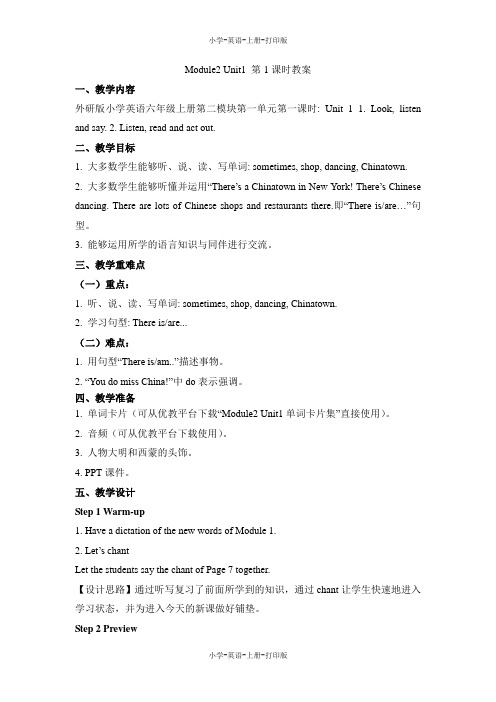
Module2 Unit1 第1课时教案一、教学内容外研版小学英语六年级上册第二模块第一单元第一课时: Unit 1 1. Look, listen and say. 2. Listen, read and act out.二、教学目标1. 大多数学生能够听、说、读、写单词: sometimes, shop, dancing, Chinatown.2. 大多数学生能够听懂并运用“There’s a Chinatown in New York! There’s Chinese dancing. There are lots of Chinese shops and restaurants there.即“There is/are…”句型。
3. 能够运用所学的语言知识与同伴进行交流。
三、教学重难点(一)重点:1. 听、说、读、写单词: sometimes, shop, dancing, Chinatown.2. 学习句型: There is/are...(二)难点:1. 用句型“There is/am..”描述事物。
2. “You do miss China!”中do表示强调。
四、教学准备1. 单词卡片(可从优教平台下载“Module2 Unit1单词卡片集”直接使用)。
2. 音频(可从优教平台下载使用)。
3. 人物大明和西蒙的头饰。
4. PPT课件。
五、教学设计Step 1 Warm-up1. Have a dictation of the new words of Module 1.2. Let’s chantLet the students say the chant of Page 7 together.【设计思路】通过听写复习了前面所学到的知识,通过chant让学生快速地进入学习状态,并为进入今天的新课做好铺垫。
Step 2 Preview老师提出以下几个问题:1. Is New York in America?2. What can you see in New York?3. Can you tell me more about Chinatown?4. Are there any Chinese shops and restaurants in New York?【设计思路】通过这四个问题的设置,可以起到承上启下的作用。
Module2Unit1It'stallerthanmanyotherbuildings教案
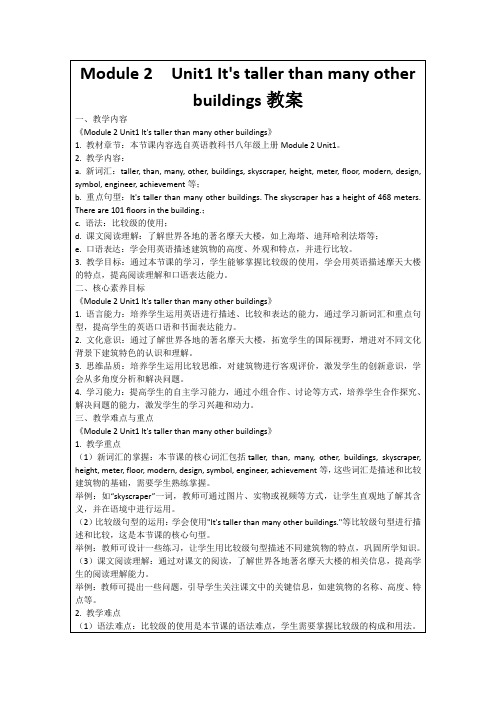
1.讨论主题:学生将围绕“摩天大楼在实际生活中的应用”这一主题展开讨论。他们将被鼓励提出自己的观点和想法,并与其他小组成员进行交流。
2.引导与启发:在讨论过程中,我将作为一个引导者,帮助学生发现问题、分析问题并解决问题。我会提出一些开放性的问题来启发他们的思考。
3.成果分享:每个小组将选择一名代表来分享他们的讨论成果。这些成果将被记录在黑板上或投影仪上,以便全班都能看到。
此外,本节课的教学中,我注重培养学生的口语表达能力。通过分组讨论、成果展示等环节,学生们的口语表达能力得到了锻炼。但同时,我也发现部分学生在口语表达时存在词汇量不足、句子结构单一等问题。为了提高学生的口语水平,我将在今后的教学中,加大词汇教学的力度,并引导学生运用多样的句型进行表达。
在课程总结环节,我让学生回顾了摩天大楼的相关知识和比较级句型的运用。从学生的反馈来看,他们对本节课的知识点掌握得较为扎实。但在教学过程中,我也意识到,对于一些基础较弱的学生,需要给予更多的关注和个别辅导,以确保他们能够跟上课程进度。
Module 2 Unit1 It's taller than many other buildings教案
一、教学内容
《Module 2 Unit1 It's taller than many other buildings》
1.教材章节:本节课内容选自英语教科书八年级上册Module 2 Unit1。
2.教学内容:
a.新词汇:taller, than, many, other, buildings, skyscraper, height, meter, floor, modern, design, symbol, engineer, achievement等;
外研社一年级起点英语第一册上Module2 Unit1 What’s your name教案 (1)
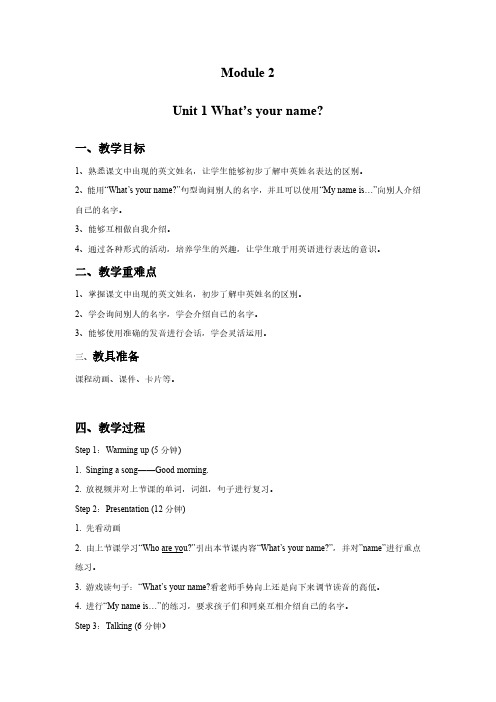
Module2Unit1What’s your name?一、教学目标1、熟悉课文中出现的英文姓名,让学生能够初步了解中英姓名表达的区别。
2、能用“What’s your name?”句型询问别人的名字,并且可以使用“My name is…”向别人介绍自己的名字。
3、能够互相做自我介绍。
4、通过各种形式的活动,培养学生的兴趣,让学生敢于用英语进行表达的意识。
二、教学重难点1、掌握课文中出现的英文姓名,初步了解中英姓名的区别。
2、学会询问别人的名字,学会介绍自己的名字。
3、能够使用准确的发音进行会话,学会灵活运用。
三、教具准备课程动画、课件、卡片等。
四、教学过程Step1:Warming up(5分钟)1.Singing a song——Good morning.2.放视频并对上节课的单词,词组,句子进行复习。
Step2:Presentation(12分钟)1.先看动画2.由上节课学习“Who are you?”引出本节课内容“What’s your name?”,并对”name”进行重点练习。
3.游戏读句子:“What’s your name?看老师手势向上还是向下来调节读音的高低。
4.进行“My name is…”的练习,要求孩子们和同桌互相介绍自己的名字。
Step3:Talking(6分钟)1.老师找一位学生进行对话示范。
T:What’s your name?S:My name is…2.再找一组同学示范,之后进行分组练习S1:What’s your name?S2:My name is…What’s your name?S1:My name is…在学生练习过程中,对他们的表现要及时给予肯定和鼓励,并再次强调本堂课的重点和难点。
Step4:Practice(4分钟)将孩子们分成4人一组,让他们分别扮演不同角色进行对话。
对孩子们的表演进行肯定和鼓励,再次强调重点。
Step5:Presentation(8分钟)放视频回顾今天的内容,带领学生们复习。
三年级英语下册 Module 2 Unit 1(1)教案 外研版

外研版三年级英语下册教案MODULE 2 ZooUnit 1 They're monkeys教材分析作为第一课时,本节新授课的学习内容是关于动物的Dialogue,由于内容比较简单,教师可以抓住时机,把本课时变成新授,听力及拓展学习相结合的学习过程。
本课时基本不存在比较难的新句型,主要设计到了描述动物的句型:What’s this? It’s … /What are they? They’re …句型,学会日常用语交际,重点要操练其用法。
Unit1通过学生们在动物园的游览呈现了询问动物,说明动物,介绍动物特点的语言结构。
教师应在课上充分利用配套的教辅材料,让学生看、听、说,并让学生模仿书中的对话进行表演,本节课需要进一步强化复数的概念, (学生在上册How many 一课中已经学习了复数的表示方法),这对扩大学生的词汇量和语言的使用空间有一定的积极意义。
因此,让学生在情境中学习语言,使用语言,增强学习的趣味性。
Unit 2中学生会学习更多描述动物外形特点的形容词,并学习一首有趣的歌曲,教师应多让学生描述较为熟悉的小动物。
本单元中还出现了二十六个字母中的前三个字母Aa, Bb, Cc,要求学生能、听、说、读、写这三个字母,并分清大小写字母,初步了解这三个字母在单词中的常见发音,学会运用字母顺序做事情。
教学目标1.语言知识目标(1)能听、说、读本节课的课文内容。
(2)进一步巩固What’s this? It’s…/What are they? They’re …句型。
2.语言技能目标(1)能用所学的知识描述不同动物名称及其特征。
(2)能够模仿录音,跟读课文中有关描述动物的句子,学生通过学习,能流利朗读和背诵课文。
3.学习策略目标及学习任务通过玩游戏、猜动物和小组合作等方式,完成本节课的学习。
What’s this? It’s a tiger. It’s big. What are they? They’re monkeys. They are small.4.运用任务:询问动物;说明是什么动物;介绍动物的特点。
Module2Unit1It’stallerthanmanyotherbuildings教案

2.运用比较级描述事物,如“It’s taller than many other buildings”;
3.掌握本节课重点词汇和句型,如skyscraper, symbol, than, as...as...等;
3.成果分享:每个小组将选择一名代表来分享他们的讨论成果。这些成果将被记录在黑板上或投影仪上,以便全班都能看到。
(五)总结回顾(用时5分钟)
今天的学习,我们了解了比较级的基本概念、重要性和应用。同时,我们也通过实践活动和小组讨论加深了对比较级的理解。我希望大家能够掌握这些知识点,并在日常生活中灵活运用。最后,如果有任何疑问或不明白的地方,请随时向我提问。
举例:让学生进行小组练习,互换角色描述物品,如“A: This book is thicker than that one. B: Yes, it’s twice as thick as mine.”
四、教学流程
(一)导入新课(用时5分钟)
同学们,今天我们将要学习的是《Module 2 Unit 1 It’s taller than many other buildings》这一章节。在开始之前,我想先问大家一个问题:“你们在日常生活中是否遇到过需要比较事物大小、高度的情况?”比如,比较两本书的厚度,或者两栋楼的高度。这个问题与我们将要学习的内容密切相关。通过这个问题,我希望能够引起大家的兴趣和好奇心,让我们一同探索比较级的奥秘。
实践活动环节,学生们分组讨论和实验操作的表现让我感到欣慰。他们能够将所学知识应用到实际问题中,并积极与同伴分享讨论成果。然而,我也注意到,在小组讨论过程中,部分学生参与度不高,可能是因为他们对讨论主题不够感兴趣或对知识点的掌握不够自信。为此,我将在下一次的教学中尝试引入更多有趣的话题,提高学生的参与度。
Module2Unit1Icanplaythepiano教案
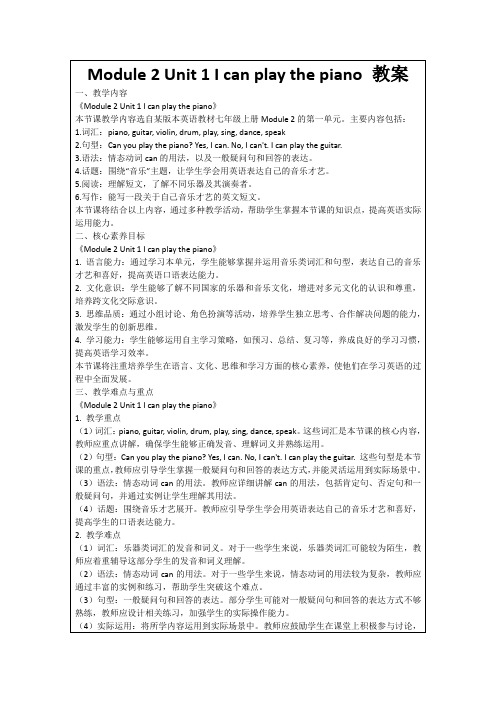
3.思维品质:通过小组讨论、角色扮演等活动,培养学生独立思考、合作解决问题的能力,激发学生的创新思维。
4.学习能力:学生能够运用自主学习策略,如预习、总结、复习等,养成良好的学习习惯,提高英语学习效率。
五、教学反思
在今天的教学中,我尝试了多种方法来帮助学生掌握《Module 2 Unit 1 I can play the piano》这一章节的内容。通过这次教学,我发现了一些值得思考的地方。
首先,我发现学生们对于音乐类词汇表现出较高的兴趣。在导入新课环节,通过提问学生们在日常生活中的实际例子,成功引起了他们对本节课的兴趣。在接下来的理论介绍和案例分析中,学生们积极参与,课堂氛围活跃。这说明,联系生活实际的教学方法能够激发学生的学习兴趣,提高他们的学习积极性。
(4)话题:围绕音乐才艺展开。教师应引导学生学会用英语表达自己的音乐才艺和喜好,提高学生的口语表达能力。
2.教学难点
(1)词汇:乐器类词汇的发音和词义。对于一些学生来说,乐器类词汇可能较为陌生,教师应着重辅导这部分学生的发音和词义理解。
(2)语法:情态动词can的用法。对于一些学生来说,情态动词的用法较为复杂,教师应通过丰富的实例和练习,帮助学生突破这个难点。
2.句型:Can you play the piano? Yes, I can. No, I can't. I can play the guitar.
3.语法:情态动词can的用法,以及一般疑问句和回答的表达。
4.话题:围绕“音乐”主题,让学生学会用英语表达自己的音乐才艺。
5.阅读:理解短文,了解不同乐器及其演奏者。
Module2Unit1Whenareyougoingtoeat(教案)外研版(三起)英语六年级下册
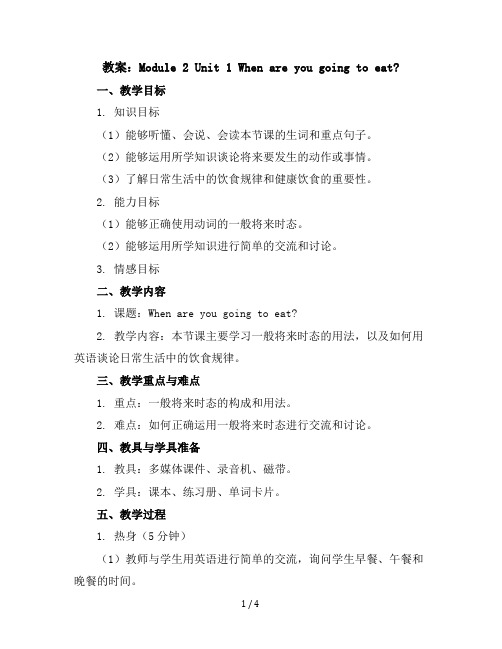
教案:Module 2 Unit 1 When are you going to eat?一、教学目标1. 知识目标(1)能够听懂、会说、会读本节课的生词和重点句子。
(2)能够运用所学知识谈论将来要发生的动作或事情。
(3)了解日常生活中的饮食规律和健康饮食的重要性。
2. 能力目标(1)能够正确使用动词的一般将来时态。
(2)能够运用所学知识进行简单的交流和讨论。
3. 情感目标二、教学内容1. 课题:When are you going to eat?2. 教学内容:本节课主要学习一般将来时态的用法,以及如何用英语谈论日常生活中的饮食规律。
三、教学重点与难点1. 重点:一般将来时态的构成和用法。
2. 难点:如何正确运用一般将来时态进行交流和讨论。
四、教具与学具准备1. 教具:多媒体课件、录音机、磁带。
2. 学具:课本、练习册、单词卡片。
五、教学过程1. 热身(5分钟)(1)教师与学生用英语进行简单的交流,询问学生早餐、午餐和晚餐的时间。
2. 导入(10分钟)(1)教师播放录音,学生跟读并模仿语音、语调。
(2)教师出示单词卡片,学生认读生词,并简要介绍这些生词的含义。
3. 新课呈现(15分钟)(1)教师通过图片和情景展示,引导学生学习一般将来时态的构成和用法。
(2)学生跟读并模仿教师的一般将来时态句子。
(3)学生两人一组,用一般将来时态进行角色扮演,练习交流。
4. 巩固练习(10分钟)(1)教师出示练习题,学生独立完成,检测对一般将来时态的掌握程度。
(2)学生四人一组,进行小组讨论,用一般将来时态编写对话。
5. 拓展活动(5分钟)(1)学生分组进行角色扮演,用一般将来时态讨论饮食规律和健康饮食。
(2)教师选取优秀表演的学生进行表扬和鼓励。
六、板书设计1. 课题:When are you going to eat?2. 板书内容:一般将来时态构成:will + 动词原形例句:I will go to the library.You will read a book.We will watch a movie.They will have dinner at 6:00.七、作业设计1. 抄写生词和重点句子。
M2U1教案外研社新版四年级上教案-module2-unit1

Module 2 Unit 1 She’s reading a book.一、教学目标:1、全体学生能理解:read, running, these, picture, take, take pictures2、全体学生能运用:语法:She’s reading a book. He’s taking pictures. 词汇:reading, running, taking, taking pictures3、学会谈论图片上正在发生的事情。
二、教学重点:1、谈论图片上正在发生的事情。
2、掌握单词:reading, running, taking, taking pictures教学难点:谈论图片上正在发生的事情。
三.教法学法:TPR, Group work, Games, Practice, Writing四、教具学具:多媒体课件,照片,单词卡片,小盒子五、教学过程:Step 1 Warm up and lead in1. Greeting.2. Read the chant of last module together.3. Show some pictures and ask the students to say something about the pictures. (展示一些照片,让学生看着照片说说照片上的人分别喜欢什么运动以及在做什么运动。
对于照片上的人正在进行的活动学生不会表达的可以用中文来说。
用中文来说了之后,询问学生同样的内容我们如果用英语来表达又该怎么说呢?学了这一课之后我们就可以用英语来表达了。
)Step 2 Presentation1. Learn the new words Before we learn the new text, we learn some new words: these, reading, taking pictures, watching TV, playing with a toy train.(1)出示单词卡片,通过集体跟读,小组跟读,开火车类型活动让学生会读新单词。
Module2Unit1Whenarewegoingtoeat?(教案)外研版(三起)英语六年级下册

教案:Module 2 Unit 1 When are we going to eat?一、教学目标1. 知识目标(1)能够听懂、会说、会读本课的生词和重点句子。
(2)能够用英语简单描述未来的计划。
2. 能力目标(1)能够运用所学的单词和句子进行简单的交流。
(2)能够根据图片或情景,运用所学知识进行简单的预测和描述。
3. 情感目标培养学生的团队协作精神,学会尊重他人的意见。
二、教学内容1. 主题:谈论未来的计划。
2. 重点词汇:week, day, morning, afternoon, evening, go, swim, shop, have lunch, watch TV。
3. 重点句型:When are we going to + 动词原形? We aregoing to + 动词原形 at + 时间段。
三、教学重点与难点1. 重点:能够听懂、会说、会读本课的生词和重点句子,能够运用所学知识进行简单的交流。
2. 难点:掌握句型When are we going to + 动词原形? We are going to + 动词原形 at + 时间段,并能够灵活运用。
四、教具与学具准备1. 教具:多媒体课件、图片、录音机、磁带。
2. 学具:课本、练习册、录音机、磁带。
五、教学过程1. 热身(5分钟)(1)播放上一课的录音,让学生跟读。
(2)老师出示一些日常用品,如pen, book, ruler等,让学生用英语描述。
2. 导入(10分钟)(1)老师出示一张日历,引导学生谈论今天的日期。
(2)老师提问:What are you going to do today? 学生回答,并引导学生谈论未来的计划。
3. 呈现(15分钟)(1)老师出示一张图片,上面有一家人在吃饭,提问:What are they doing? 引导学生回答:They are eating.(2)老师出示一张图片,上面有一家人在游泳,提问:What are they doing? 引导学生回答:They are swimming.(3)老师出示一张图片,上面有一家人在购物,提问:What are they doing? 引导学生回答:They are shopping.(4)老师出示一张图片,上面有一家人在看电视,提问:Whatare they doing? 引导学生回答:They are watching TV.4. 练习(15分钟)(1)老师引导学生分组,每组选择一张图片,用英语描述图片内容。
四年级英语上册 Module 2 Unit 1(1)教案 外研版

关注点 修改补充
Step1.Warming up
1)老师带领学生复习上一模块学习的韵诗。
2)老师组织学生参加“Simon says(听口令做动作)”的游戏,复习巩固祈使句的用法。老师要尽量多使用“left”和“right”等单词,如:Hands up ,Hands down, Left hand ,Right hand .为本课的教学做好准备。
活动二:认识美丽的建筑物
教师逐一展示6个有关建筑物的图片,并将图片贴在黑板上ห้องสมุดไป่ตู้采取不同的方式认读:
schoolzoosupermarkethospitalhousesstation
教师在一瞬间将黑板上的单词卡片逐一取下,边取边让学生观察,什么图片不见了。说出相关单词。
活动三:New lesson
1.教师请同学们打开课本观察课本上的八幅图.请学生自由讨论,试着说一说图画中的内容。然后老师放录音,请学生边听录音边指向对应的图读。老师再放一次录音订正答案,并让学生重复或者教师领读。
2.老师组织学生进行比赛:老师任意描述出出课文中的图片,请学生快速说出对应的句子,反应最快的学生获胜并得到奖励。
3.试着完成SB活动3。先请学生小组自由讨论并用问路和指路的方式进行对话表演。
Step3Consolidation and extension
1.每个学生拿出一张空白纸,让学生根据老师的指令画出方向示意图。
外研版(三起)四年级英语上册教案
学科
英语
课题:Module2 Unite1 Go straight on .
课型:新授
知识点
学情分析
1.掌握 Go straight on. Turn left/right. Stop! Don’t go! 句型;2.运用这两个句型。3.使用祈使句指示方向和路线4.培养学生的合作意识。5.培养学生听说读写的能力。6.通过本课的学习使学生能够遵守与交通规则相关的指令。四年级的小学生经过过去长时间的英语学习,已经具有一定的听说读写能,而且他们的记忆力和方位感在这个年龄阶段是旺盛时期,所以在本单元学生的听说以及表演很有可操作性。
- 1、下载文档前请自行甄别文档内容的完整性,平台不提供额外的编辑、内容补充、找答案等附加服务。
- 2、"仅部分预览"的文档,不可在线预览部分如存在完整性等问题,可反馈申请退款(可完整预览的文档不适用该条件!)。
- 3、如文档侵犯您的权益,请联系客服反馈,我们会尽快为您处理(人工客服工作时间:9:00-18:30)。
MODULE 2 TEACHING PLANContent:Module 2 Experiences一、题材内容本模块以经历为话题,语法重点是现在完成时句子的用法, 并能谈论自己和他人的过去经历。
该话题为学生所熟知,非常有利于开展听、说、读、写方面的语言实践活动。
通过操练,使学生在掌握语言结构的同时,既学习语言知识,感悟语言功能,又能熟练介绍自己或他人过去的生活。
本模块的learning to learn栏目介绍了迪斯尼乐园的有关知识,通过学习可以激发学生探索世界的兴趣。
在阅读过程中,学会应用寻找细节的阅读技巧,能将单词与释义相匹配。
教学中教师应随时随地以课本为出发点,灵活利用各种素材组织教学过程和内容。
充分调动学生的积极性。
教学目标1)语言知识:2)语言技能:3)学习策略4)文化意识:5)情感态度:通过学习描述过去生活,提高对英语的学习兴趣。
参加各种英语活动,克服困难,在新环境中进一步树立准确的语言学习观。
6)任务:能够运用动词现在完成时表述自己或他人过去的经历。
教学重点和难点重点:1.掌握描述过去经历的基本词汇,读懂含有现在完成时的句子,掌握动词现在完成时的陈述句、一般疑问句及肯定和否定回答形式和用法。
难点:掌握现在完成时的结构和用法。
教学方法基于课程改革的理念及“第二语言习得论”,培养实现人的可持续发展和人的主体精神的自我完善和发展所必需的能力和素质,运用任务型教学途径,围绕核心任务,设定小任务,开展和谐愉悦的课堂活动,强调兴趣第一的原则,初步设计“P—T—P”自主学习立体模式:pre-task…task-cycle…post-task。
二、教材处理核心任务:能够运用所学句型结构描述经历。
三个环节如下:pre-task:学生联系生活实际,激活背景知识,。
task –cycle:通过整个模块的听说读写的训练,强化对“过去经历”的表达能力,为完成任务做好铺垫post-task:达成任务,展示成果,反馈学习情况三、教材安排根据学生学习英语的特点和规律,我们把本模块划分为4课时:Period 1: Listening and V ocabulary &Pronunciation and SpeakingPeriod 2: Reading and V ocabularyPeriod 3: Writing& Around the world &Module TaskPeriod 4: Language in use注:教学时应根据学生的学习水平、生活实际水平、接受程度及课堂出现的临时状况进行运用、调整及筛选。
『教学设计』Title:Module 2 ExperiencesPeriod 1: Listening and Vocabulary &Pronunciation and SpeakingTeaching Content: Listening and Vocabulary and Pronunciation and Speaking Teaching Aims and Demands:1. Language KnowledgeKey vocabulary and phrases:experience, ever, competition, airport, cabin, steward,captain, country, before, problem, wonderful, prize, reckon,sound, brilliant, dream, someone, kind,take offKey structure: have/has + p.p. (重点)2, Listening skill: To understand conversations containing the present perfect tense. (难点)3.Speaking skill: To talk about one’s past experiences4.Affection and attitudes: We should love life.Learning strategies:Bottom –up approach and listening to the tape and do some exercises.Teaching Aids: Multi-Media (Tape recorder, video, OHP, handout)Teaching Procedures:Part I: RevisionTask: Recall what we have learned in the last Module.Directions:Step one: Label the pictures with the phrases.(1). Read through the phrases in the box and have the Ss. Repeat them after you.(2).Ask them to label them in the pictures on the screen.(3).Make some sentences with the phrases. Ask students to speak out as many as they can.Step two: Talk about giving advice. Eg.(1).You should always speak English in class.Why don’t you write down the correct words?It’s a good idea to check your vocabulary notebook.How about listening to the radio in English?But try not to translate every word.Everyone should have a pen friend.You should go to bed before 9 o’clock, and get up at half past six.You should listen to the teacher carefully in the class.Try to speak English in class.I think it’s a good idea to write words in groups.(2). Have a competition speaking out the words. Eg. Speak out the words about studyingplan.Ask students to speak out as many as they can.Part II: Lead in:Task 1: Introduce to them the new words.Directions:Step one: Introduce the new words of this unit. And list them on the board.Step two: Read after the teacher.Step three: Practise reading the words.Step four: Ask the students to look at the pictures. Elicit what they can see. If there are anynew words, add them to the list on the board.Step five: Make some sentences using the new words from the whole class.Task 2: Introduce to them the present perfect tense.Directions:Step one. Elicit a few sentences from the Ss. (e.g. I saw the film yesterday. I have seen the film. I don’t want to see it again.) and write them on the blackboard.Step two: Then write the following:Have you seen the film? Yes I have./ No, I haven’t.Has he seen the film? No, he hasn’t./ Yes, he has.Step three: Practise the tense with some sentences:I answered all the questions yesterday. I have answered all the questions.( Point to a student) Have you answered all the questions?( Point to a boy) Has he answered all the questions?( Point to a girl) Has she answered all the questions?And so on.Step four: Have the Ss. make some other sentences. (e.g. have visited America/ have cleaned the floor…)Step five:规则动词的过去分词变化规律:①.原形+ed,如:work—worked—worked; visit—visited—visited②.字尾为e时,只需加-d,如:like—liked—liked; live—lived—lived③.字尾为“元音字母+y”,保留y,直接加ed。
如:play—played—played; stay—stayed—stayed④.字尾为“辅音字母+y”时,将y改为i,现加ed,如:study—studied—studied; cry cried—cried⑤.字尾只有一个辅音字母的重读闭音节词,将最后的辅音字母重复后再加ed,如:stop—topped—stopped; drop—dropped—droppedPart III: Listening1.Task: listen and then number the words and expressions in activity 1 on page 10.Directions:Step one: Read through the words and expressions and make sure the Ss understandthem all.Step two: Play the recording and have them listen to the recording and focus on the words first time through.Step three: Play the recording again and have them number the words andexpressions, then check with a partner.Step four:. Play the recording again for them to check. Then Call back the answerfrom the whole class.Step five: Let the Ss look at the picture in Activity 2 and say which of the words inActivity 1 you can see .Step six: Talk about the picture briefly.2.Task: To understand conversations .Directions:Step one: Today we’re going to listen to a conversation between Tony and Lingling.They’re talking about experiences. Listen and answer this question:Where was Sally from?What was the first prize?Make sure the Ss. understand the questions:Step two: Play the recording and have them listen.Step three: Play the recording again and have them write the answers individually.Step four: Play the recording and have them check their answers with a partnerStep five: Call back the answers from the whole class.3.Task: activity 4on page 11.Directions:Step one: Play the recording again and have them check the things Lingling and Sally have done individually in Activity 4. Have them check their answers with a partnerStep two: Play the recording again.Call back the answer in a whole- class setting.Step three: Ask and say what Lingling and Sally have or haven’t doneStep four: Listen and check.4 .Task: Listen and read:Directions:Step one: Play the recording and ask the Ss. to listen and read the conversation.Step two:Play the recording again and pause after each phrase, asking the Ss. to repeat chorally and individually.Step three: Put the Ss. into groups of 2 to practise the dialogue.Step four: They should repeat it several times, changing the roles each time.5. Task: activity 6 on page 11.Directions:Step one: Pair the Ss to answer the questions about the words in the box.Step two: Ask some pairs to act in front of the classroom.Part IV: Pronunciation and speakingTask: Listen and repeat the questions and answers in Activity 5 and 7 Directions:Step one: Play the recording and ask the Ss. to listen and repeat the questions and answers in Activity 7.Step two: Ask the Ss to pay particular attention to the intonation and the sentence structure of the sentences.Step three: Ask the Ss to ask and answer the questions in activity 7.Step four: Pair the Ss to ask each other and answer the questions in Activity 7Part V: A testListen to the tape and translate some of the sentences into Chinese.Part VI: Homework:Recite the short dialogue as fluently as possible.Period 2V ocabulary and ReadingTeaching Content:V ocabulary and ReadingTeaching Aims and Demands:1. Language knowledge:New words: western, abroad, fantastic, anywhere, Chinatown, Italian, delicious, pizza,sandwich, musician, dagger, seat, beside, taste, come true, more than,sell outKey structures: has + past participle(重点)2.To get information from the reading material about one’s experiences.3. Affection and attitudes: We should love life.Learning strategies: Communicative approach.Teaching Aids: Multi-Media (Tape recorder, video, OHP, handout)Teaching Procedures:Part I: Revision1.Help students to revise what is learnt in Period one of this module.Show them some pictures about the new words in last period. Have the Ss. spell them chorally and individually.2.Revise规则动词的过去分词变化规律:①.原形+ed,如:work—worked—worked; visit—visited—visited②.字尾为e时,只需加-d,如:like—liked—liked; live—lived—lived③.字尾为“元音字母+y”,保留y,直接加ed。
